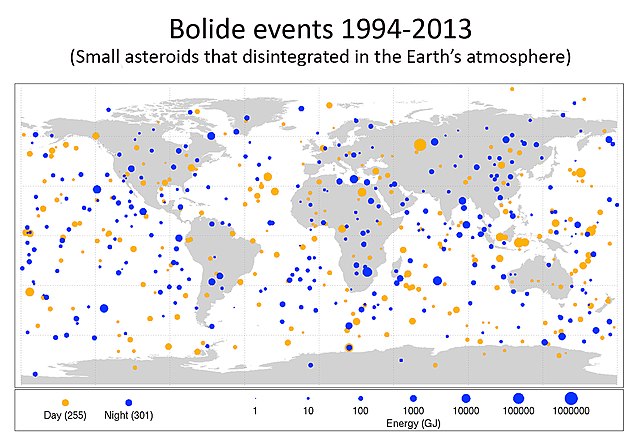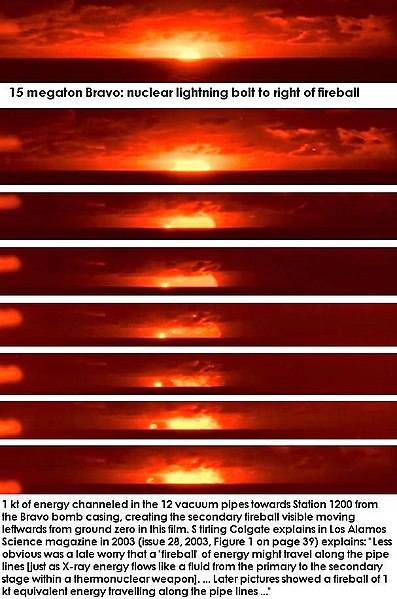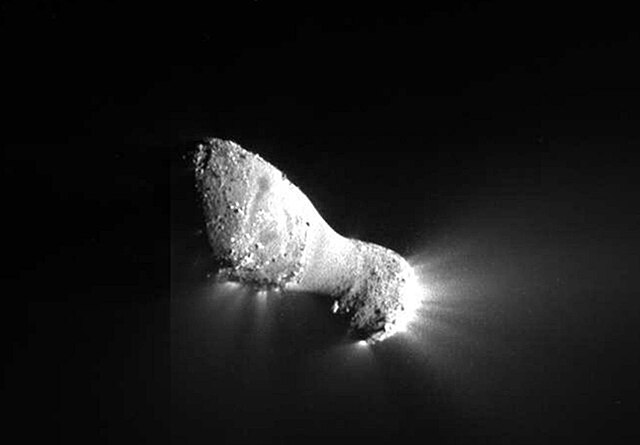Asteroid impact avoidance
Asteroid impact avoidance comprises the methods by which near-Earth objects (NEO) on a potential collision course with Earth could be diverted away, preventing destructive impact events. An impact by a sufficiently large asteroid or other NEOs would cause, depending on its impact location, massive tsunamis or multiple firestorms, and an impact winter caused by the sunlight-blocking effect of large quantities of pulverized rock dust and other debris placed into the stratosphere. A collision 66 million years ago between the Earth and an object approximately 10 kilometers wide is thought to have produced the Chicxulub crater and triggered the Cretaceous–Paleogene extinction event that is understood by the scientific community to have caused the extinction of all non-avian dinosaurs.

Damage caused by the Tunguska event. The object was just 50-80 metres (150-240 feet) across and exploded 6-10 km (4-6 miles) above the surface, yet its explosion flattened 80 million trees and shattered windows hundreds of kilometres away.
Frequency of small asteroids roughly 1 to 20 meters in diameter impacting Earth's atmosphere.
In a similar manner to the earlier pipes filled with a partial pressure of helium, as used in the Ivy Mike test of 1952, the 1954 Castle Bravo test was likewise heavily instrumented with line-of-sight (LOS) pipes, to better define and quantify the timing and energies of the x-rays and neutrons produced by these early thermonuclear devices. One of the outcomes of this diagnostic work resulted in this graphic depiction of the transport of energetic x-ray and neutrons through a vacuum line, some 2.3 km long, whereupon it heated solid matter at the "station 1200" blockhouse and thus generated a secondary fireball.

This early Asteroid Redirect Mission artist's impression is suggestive of another method of changing a large threatening celestial body's orbit by capturing relatively smaller celestial objects and using those, and not the usually proposed small bits of spacecraft, as the means of creating a powerful kinetic impact, or alternatively, a stronger faster acting gravitational tractor, as some low-density asteroids such as 253 Mathilde can dissipate impact energy.
A near-Earth object (NEO) is any small Solar System body orbiting the Sun whose closest approach to the Sun (perihelion) is less than 1.3 times the Earth–Sun distance. This definition applies to the object's orbit around the Sun, rather than its current position, thus an object with such an orbit is considered an NEO even at times when it is far from making a close approach of Earth. If an NEO's orbit crosses the Earth's orbit, and the object is larger than 140 meters (460 ft) across, it is considered a potentially hazardous object (PHO). Most known PHOs and NEOs are asteroids, but about 0.35% are comets.
Image: Asteroid 2006DP14
Image: The VLT images the very faint Near Earth Object 2009 FD
Image: Comet Hartley 2
Radar image of (388188) 2006 DP14 recorded by a DSN antenna







